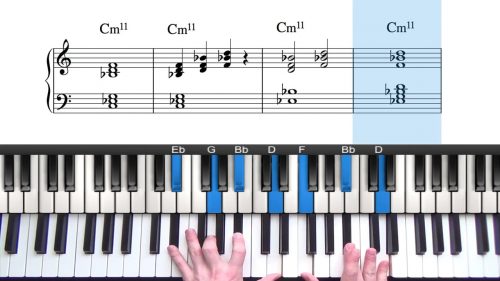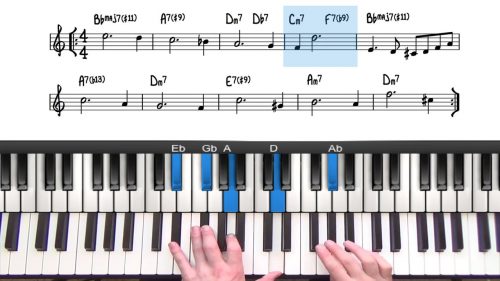My Funny Valentine Tutorial Part 1
My Funny Valentine is one of the classic jazz standards! A difficult tune to learn, in this lesson we breakdown the complicated chord changes and build a solo arrangement. Written in the key of C minor, the tune follows a 36 measure A, A, B, A form. Although the tune starts in C Minor, it shifts to the relative major, Eb, during the bridge.
To play this tune effectively, you should have a good understanding of the minor line cliche which is one of the most common chord progressions in jazz music. This four chord progression appears 3 times in the form and so understanding the root movement will give you a variety of voicing options. The minor line cliche has become synonymous with this tune and is sometimes referred to as the ‘My Funny Valentine Progression’.
We start this lesson slightly differently by analysing Herbie Hancock’s intro on the Miles Davis Sextet version of My Funny Valentine. Worth listening to if you haven’t already.
Practice Tips
-
My Funny Valentine is a widely recorded jazz standard so there are lots of records to draw inspiration from.
-
Check out the recordings below which are some of PianoGroove's favourites.







Hey around 6:30 you played a voicing for a cmM7! Why are you not playing the note ” b ”. Does it give more flavour playing a Bb instead of b please elaborate?
Hello Hayden good morning.. In the minute 6.50 se have a CmMaj7 chord..you are Just using 2 chord tones ..the B and the G.Can we say that me more chord notes there is on a voicing the more grounded it sounds and the more extensions and alterations the more exótic and out of place it sounds?I think we all know thats the case..but i really need your affirmation about this statement to fully integrate it in my brain for life.Have a good day
YAY. I started learning this song today! Stunning arrangement! Only question I have is on bar 28 where there is an F, A#, Bb and Eb …curious why B needed to be notated if it was just the enharmonic of A#? Big thanks in advance :)
Hi Tina 👋
That was a typo… it was supposed to be a B Natural.
I have fixed this now, thanks for spotting it.
The A# is the #9 of G7, and the B Natural is the major 3rd.
We cover these voicings in more detail in the upcoming course on “Altered Harmony”: pianogroove.com/jazz-piano-lessons/altered-harmony-upper-structure-triads/
Check out that course for more information.
Cheers,
Hayden
Thanks very much Hayden! just a follow up question :) this means the B on the treble clef notes will be a natural as well ? and the A becomes a # too – then the chords on the treble clef would be a combo of
B natural, Eb and G
A sharp, Db and F ?
really dig this song but because I’m not familiar to the song very much – needed to ask to be sure :) Thanks very much in advance!
or does the natural B and sharp A on bass (bar 28) applicable only on the bass clef notes and not treble notes? am suddenly needing to have a good recall! :) Thanks in advance
Hi Tina 👋
The A# and B natural would just apply to the bottom staff.
So for the right hand part we are playing Ab and Bb in the melody.
You can also look at the right hand part as an Eb Major triad alternating with a Db major triad.
This is 2 upper structure triads over the G7. Eb triad over G7 gives us G7#5#9 and the Db triad over G7 gives us G7b9#11.
Check out our course on altered harmony where we explore these chords in more detail: pianogroove.com/jazz-piano-lessons/altered-harmony-upper-structure-triads/
Any other questions let me know.
Cheers,
Hayden
Hi Hayden!
Thanks for this arrangement! I’m just starting, and might have a few questions. In the first bar, what’s the theory behind playing that A flat? And is there somewhere I can go to answer questions like this on my own?
Thank you!
Hi Theo,
Apologies for the late reply here.
Abmaj7 is a diatonic 7th chord from both C Natural Minor, and C Harmonic Minor and moving from the i-7 chord to the VI major 7 chord creates an interesting sound. Essentially we are just moving between the chords in the key/scale to create an intro.
I recently created a lesson which talks about this exact movement. Check out chapter 4 of this lesson “Vamp i to IV” – pianogroove.com/jazz-piano-lessons/minor-introductions-1625s/
To answer questions on your own, you can first search in the forum area. You can also post questions in the forum to get insights from myself, our other teachers, and our other students.
Again apologies for the delayed response Theo and hope the above helps. Definitely check out the lesson I reference and it should give you some cool ideas to develop this tune further.
Cheers,
Hayden
HI, is there a reason why you play a Bb instead of a D in the melody (as notated) at 8:09?
Hi Max,
That is a typo in the notation – it should be a Bb as played in the demonstration.
Apologies for the confusion.
Always follow what is being demonstrated on the keyboard as sometimes these little typos can creep into the notation.
On a related note, we do have a lot of freedom when playing jazz standards and we don’t always have to play the melody exactly as written on the lead sheet.
If we pick 10 jazz arrangements of the same song on YouTube or Spotify, we will hear that each one has it’s own nuances. The melody will be phrased differently, the arranger will add notes in, take notes away, etc… and so a lot of this is down to personal interpretation.
Cheers and enjoy the lessons!
Hayden
bonjour, j’ai etudié my funny Valentine partie 1 mais je n’ai pas la partie 2 , je n’ai que deux fois la parti 1 dans les cours de standart !
Merci Hayden :)
Bonjour Remy,
Vous pouvez trouver la partie 2 ici: pianogroove.com/jazz-piano-lessons/funny-valentine-part-2/
Cheers,
Hayden
Merci beaucoup ! vos cours sont super !! :)
I am working through this arrangement now and finding it quite a challenge! It is certainly a big jump in difficulty from some of the earlier ones in the course. And I notice that you sometimes play ninths which are not listed in the lead sheet. And you don’t point them out in the video either. So it can be confusing sometimes.
That said, I do like your general approach very much.
Hi Bruce,
Yes I added this tune at the end of the course to prepare students for what’s coming next. Don’t worry if everything doesn’t make complete sense right now, the main thing is that you are exposing yourself to the new theory, the new sounds, and the new voicing shapes.
Regarding the 9th, and other extensions, it’s common practice for jazz musicians to abbreviate the chord to just “7” even if it includes 9ths, 11ths, and 13ths, and whilst I try to make a habit of explaining exactly what is in the chord, sometimes I might overlook this.
The same applies with lead sheets, when we see just “7” next to a chord symbol, we usually have the creative freedom to add 9ths, 11ths, and 13ths which is a useful thing to understand.
I’m glad you are enjoying the lessons and let me know if I can help further.
Cheers,
Hayden
Just starting on this one, and it’s challenging! I can’t make the stretches in measure 3 and 4. I could need a suggestion on how to play the left hand Fm13 and Eb6/9? (from the transcription). Is it better to roll it with pedal? Just omit the A in the FM13 and the Gb of the Ebm, or just simplify using an invertion of the cord or play a simpler Fm7?
I have tried but can decide on what sounds best. I feel the cord becomes muddy if the A in fm13 is played low and something is missing without it, i think it might sound better with the 7. Eb instead?. If I invert the cord to CFAb i feel i am missing the F in the bottom, and it becomes to light and airy.
I would love to hear your opinion on how to simplify these streches!
Hi Gisle,
Great questions here.
My main advice is to try rolling with the pedal. Take the 3 notes of the Fm triad (F-C-Ab) voiced over a 10th. Can you reach C to Ab with your index finger and thumb? If so, you should have no problem rolling the notes with the pedal and using your index finger as the “pivot point”.
Another option is just to play the R-5 or R-7 shell in your left hand and try to fill in the other notes with your right hand. Sometimes we can omit notes completely and it sounds just fine with the left hand shell.
A final option would be to introduce a left hand stride style where we play root and 5th in our left hand, and then a rootless voicing with our left hand too.
Please try those and let me know how it works for you :–)
Cheers,
Hayden